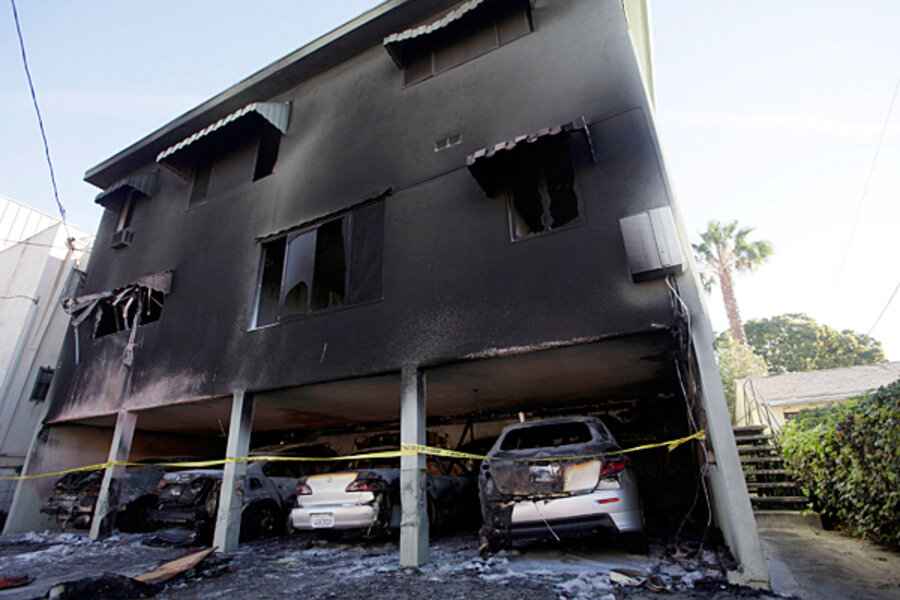L.A. arsons: Coordination among agencies, with public credited in arrest
Loading...
| Los Angeles
Law-enforcement officials have charged a suspect in the four-day arson spree in Los Angeles – and many are calling it a model of coordination not just between five separate local and federal agencies, but also with the civilian community.
As the streets of North Hollywood and other L.A. communities pulsated with police and fire-engine sirens, helicopters buzzed overhead in response to the eruption of some 55 fires between Dec. 30 and Jan. 2. On Sunday morning, police released a shopping-mall surveillance video to the public, and by 10 p.m. that night, a tipster had identified the ponytailed man seen in the images. By 3 a.m., a rookie police officer had stopped and taken into custody Harry Burkhart, a German national in his 20s who was living in Hollywood.
"Our long, four-day nightmare is over," said L.A. County Supervisor Zev Yaroslavsky at a press conference Monday, who himself lives just a few blocks from one of the fires allegedly started by Mr. Burkhart. “I want to thank city and county fire departments, the LAPD, and the [federal Bureau of Alcohol, Tobacco, Firearms and Explosives] for the incredible job they did for the people of the West Valley and West Hollywood.”
Forty-five fires occurred in the Los Angeles area, another nine were in West Hollywood, and one was in Burbank, according to Erik Scott, a spokesman for the Los Angeles Fire Department. Most were burning cars and fires in carports.
Several officials – including LAPD Chief Charlie Beck, L.A. Mayor Antonio Villaraigosa, and LAFD Chief Brian Cummings – spoke glowingly of the collective work of a quickly constituted joint task force, which was made up of the Los Angeles County Sheriff's Department, Los Angeles County Fire Department, Los Angeles Police Department, Los Angeles Fire Department, and members of the Bureau of Alcohol, Tobacco, Firearms and Explosives (ATF).
The remarks have been echoed by national observers.
“This has been a very unusual level of cooperation between different agencies and levels of government, and to have pulled it off over a holiday weekend makes it all the more remarkable,” says Mary Powers, president of the National Coalition on Police Accountability in Chicago. “The fact that a citizen tipped them off also points to a positive relationship the LAPD has been able to establish with the city. Police watchdog groups didn’t know if the level of cooperation established by [former police chief William] Bratton would continue after his retirement.”
The LAPD’s reputation, she notes, has suffered deeply over the past two decades from incidents ranging from the Rodney King beating to a scandal involving hundreds of officers accused of planting evidence. But this is the second time since May that the LAPD has arrested a key suspect with the help of citizens. In the first incident, the LAPD thanked the public for 700 leads they gave that led to the apprehension of a suspect in the March 31 beating of San Francisco Giants fan Bryan Stow at Dodger Stadium.
“This shows how the force as a whole seems to have made [Mr. Bratton’s] advances in crime fighting their own,” Ms. Powers says. “They are continuing to work well with the public, unlike police in other large cities, certainly here in Chicago.”
Because of a comment that Burkhart apparently made while being taken into custody, early speculation was that he may have been battling the US government over the immigration status of his mother, who is reportedly being deported. But officials emphasized they don’t know if this had anything to do with why he allegedly set the fires.
The fires have caused an estimated $3 million in damage, authorities said.
More information is likely to come out about Burkhart in coming days, officials say. "By no means is this investigation complete," noted Mayor Villaraigosa.
Officials cautioned Los Angelenos not to let down their guard just because a suspect is in custody.
“We want the public to know that our big concern now is that he may not have acted alone,” said Chief Beck in a Monday evening press conference. “The Sheriff’s Department, the LAPD, and the fire department are now acting with the premise that he did not act alone.”
Burkhart is currently being held without bail.
Villaraigosa admonished potential copycatters, "These crimes will not be tolerated in the city of Los Angeles." He added that should anyone mimic one, "know that we will find you, we will arrest you, and we will prosecute you to the fullest extent of the law."





